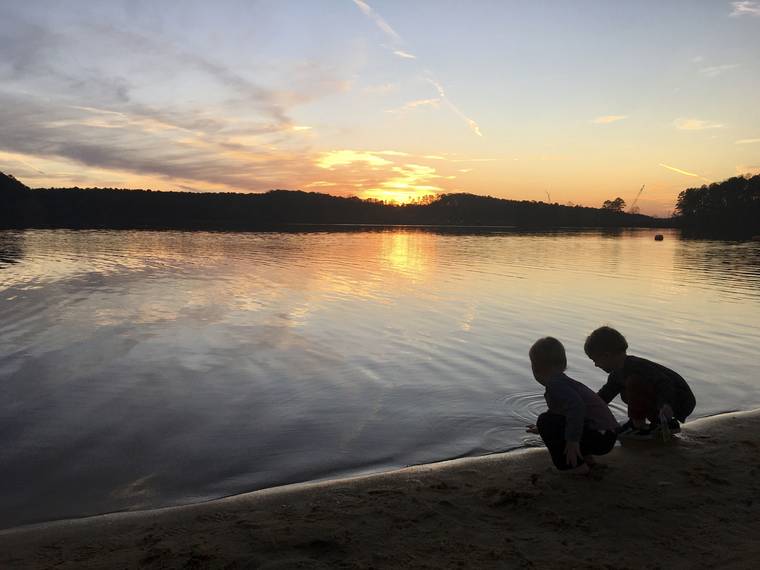She’d wanted to frame and hang them — just three printed pictures that had been sitting in Lucy O’Donoghue’s suburban Atlanta house since the year began. That’s all. Yet with a full-time job and two small kids, she hadn’t found the time.
But when COVID-19 slowed life to a quarantine-induced crawl, she began working remotely. It seemed like the perfect time to get this — and a slew of other small projects — done.
Eight months later, O’Donoghue finally walked the two short blocks to a store near her house and bought a trio of ready-made frames.
“I put the pieces of art up in my house, and that made me so happy,” she says. “How is it that something that only took me 45 minutes has taken me over a year to get around to doing?”
The answer, as it has been with so much, is this: Because 2020.
Ten months ago, Americans waded into unfamiliar waters. For many who were not plunged immediately into economic or medical emergency, it was as though some strange, protracted, fragmented snow day had begun. Plans and promises bloomed on social media like spring flowers. Bread was baked. Projects were launched.
“With the greatest of intentions, in the first few weeks people had rearranged their shoe closets and made their spice racks alphabetical,” says psychologist Deborah Serani, an adjunct professor at Adelphi University in New York.
But when life is difficult, sustaining even a small amount of momentum can be tough.
PSYCHOLOGICAL LABOR
The pandemic requires new levels of vigilance and decision-making, and it has disrupted millions of families. The presidential election required deft calibration to get along peaceably with relatives or friends with differing views. This year saw an escalation in crises social, racial and environmental.
All of this has required tremendous psychological labor. That work is invisible, but it takes its toll, says Catherine Sanderson, chair of the psychology department at Amherst College.
For much of the nation, the sense in the early days of quarantine that the disruption would be brief soon melted into an amorphous uncertainty.
“Uncertainty,” Sanderson says, “is extraordinarily psychologically taxing.”
The normal guardrails that govern the days — getting dressed and out the door on time, driving kids to sports practices and dance classes on a tight schedule in the evenings — disappeared for many. So while having extra time might have seemed like a bright spot, it was also disorienting.
With too much unstructured time, “I feel this aimlessness,” says Steph Auteri, a writer who lives in Verona, New Jersey. “The busier I am, the better I operate. The more time I have, I start to get down in the dumps.”
That’s a common experience, says Serani: In the United States, “it’s a really high-octane life. And it was slammed. We hit the brakes and everybody had to stop, and it was hard for many people.”
This year has required us to create new structures. That takes time and energy.
Pre-pandemic, “on a Saturday, you wouldn’t wake up in your office. There’s a distinction. And now, you have to actually think about, ‘What am I doing?,’” Sanderson says. “It requires a level of planning that you’re not used to and that we don’t have practice with.”
Yet amid all this uncertainty and psychological labor, people are looking back and realizing they did discover a quiet productivity.
In her Queens, New York, home, months of quarantine led Neesa Sunar to return to playing viola after many years away. Auteri made progress too, reorganizing her schedule around helping her 6-year-old daughter with remote learning, and eventually launching an educational website in time for the start of school in September.
Yoga teacher Pamela Eggleston shifted her teaching online, filming a self-care course for Yoga Journal to help people thrive during this challenging year. Teaching exclusively online “was a challenge for me. But I did it,” she says. Though she’s based in the Washington, D.C., area, she soon had students tuning in from as far away as Scotland.
And something else: She returned to social justice activism this year.
“I’ve done more of that than I had done in a while,” Eggleston says. “It feels good to me to return to these issues. They never leave me, as a Black woman.”
WHAT REALLY MATTERS
Tough times can be clarifying. They aren’t always so, but they can be.
People may not have tackled the home improvement projects they planned or written novels. But many focused on their own well-being, and their kids’, and asked themselves what really matters.
In the past, business coach Rachel Brenke says, she might have seen quarantine as a time to be highly productive — and would have beaten herself up if she wasn’t. “I’m normally someone that thrives on always being busy, jumping from one thing to another,” she says.
Instead, she prioritized keeping a healthy balance between managing her business and connecting with her family.
“My big thing this year, just out of purely trying to focus on my kids, myself and my mental health, was simplicity. So I’m carrying that over into 2021 with intentional simplifying,” she says.
So with those early-quarantine resolutions in mind, how do we approach this weekend, the moment of shaking off 2020 and invoking fresh New Year’s resolutions for 2021?
Serani expects many people’s resolutions will be focused less on material goals and more on what they’ve decided is most important.
That might even include gratitude for the old, familiar, repetitive routines they used to dread.
“I’ve sort of longed for that bit of the day where I’ve got my handbag over my shoulder and my lunch bag. And I’ve shut down the laptop and I’m walking back to my car in the same parking spot as always, and I feel the fresh air,” O’Donoghue says. “I almost dream of that moment.”


